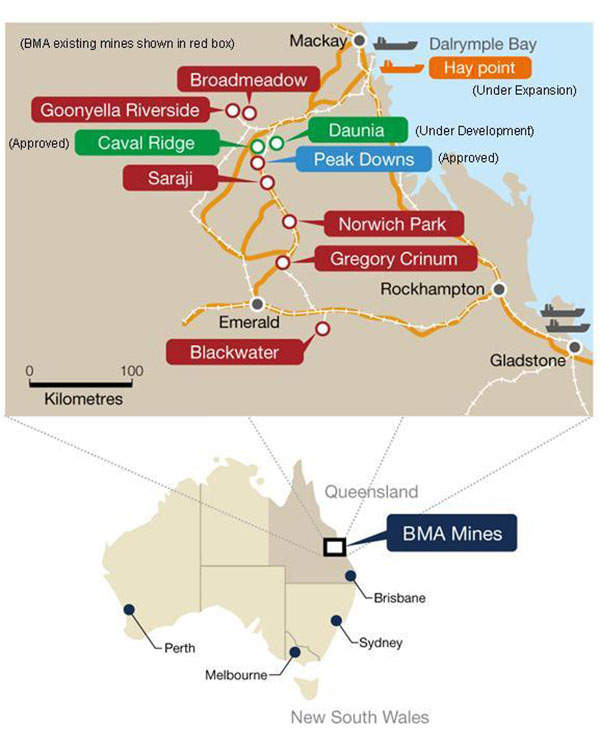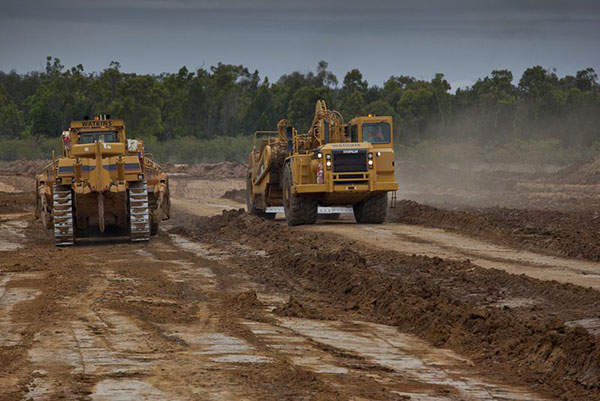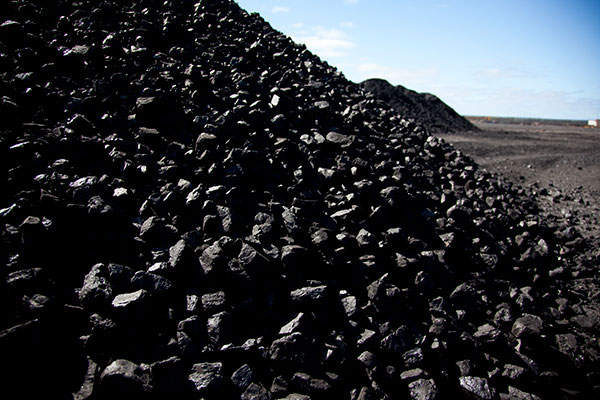Cavil Ridge is a high-quality, hard coking coal mine located in the Central Queensland region, Australia. The project site is situated in the northern section of the Bowen Basin, approximately 3.7 miles (5.95km) south-east of Moranbah and 100 miles (160.9km) south-west of Mackay. The local government authority is Isaac Regional Council.
The greenfield project covers an area of approximately 6,800ha and comprises two coal pits, namely Horse Pit and Heyford Pit. The former deposit lies north of Peak Downs Highway, while the latter is situated north of Harrow Creek.
The two main components of the Cavil Ridge project include the development of a new coal mine and installation of a coal handling and preparation plant (CHPP).
Construction on the project was commenced in the first quarter of 2012 and was completed in 2014, below budget. The first coal was produced in October 2014, three months ahead of schedule. The initial cost of the project was approximately $3.4bn. The development created 2,000 construction jobs and 500 operational jobs.
The Cavil Ridge asset is owned jointly by BHP Billiton and Mitsubishi, through their 50-50 joint venture company, BHP Billiton Mitsubishi Alliance (BMA). The joint venture is reportedly the largest coal producer in Australia.
Bowen Basin geology
The mine is placed on the western section of the northern Bowen Basin, which contains a comparatively thinner collection of sediments. Minor to moderate deformation can be seen in the area. The area contains Permo-Triassic (PT) sediments arranged in stratigraphic sequences.
The project extracts coal seams from the Moranbah Coal Measures (MCM), whose lithology broadly comprises 305m of pulverised sandstone, siltstone, mud-stone, clay-stone and coal. It targets to unearth all the seams that are greater than 11in in thickness.
Mining operations at Cavil Ridge
The coal from the Cavil Ridge coal mine is excavated through open cut mining operations using a conventional dragline excavator and truck fleet. The mine produces approximately 5.5 million tons of hard coking coal a year. An on-site CHPP has been built to process the coal.
Overburden removal and coal mining are the two main components of open cut mining operations at the Cavil Ridge project.
The overburden is removed by a combination of draglines and truck shovel fleet. The majority of the overburden is cleaned using a dragline. The truck shovels are due to be deployed when the pits run deeper and an increased quantity of overburden is required to be removed.
The open cut mining operations at the mine are carried out by employing strip mining technique. The strips typically measure 1,500m to 2,000m in length and 60m in breadth, and are built in a north to south direction along the coal seams discovery.
The coal seams are excavated by employing a combination of excavators, front-end loaders and large capacity coal haulers.
The coal bed is first exposed, subsequently blasted and then loaded into trucks for hauling. The run-of-mine (ROM) coal is sent to a raw coal stockyard for processing. Waste material resulting from the handling and processing of coal is returned into the pit and placed within the spoil.
Coal handling and preparation plant (CHPP)
The designed processing capacity of the CHPP is 14 to 15 million tons per annum (Mtpa). The plant will be capable of producing 8Mtpa, including 2.5Mtpa of coal from the expansion of the neighbouring Peak Downs Mine.
The CHPP is based on a single-stage process incorporated with dense medium cyclones, spirals and flotation circuits. The minimum structural design life of the plant is three decades.
Infrastructure of Queensland’s coal mine
Infrastructure and facilities developed for the mine’s operations include roads, dams, administrative buildings, water and wastewater treatment plants, along with a mine industrial area.
Raw water for the potable water treatment plant is sourced from the Eungella-Bingegang pipeline. The plant is located next to the raw water dam, at the southern end of the mine industrial area.
It has a design capacity of 20,000L each day and treats the mine’s sewage. The treated effluent is reused for the mine’s operations.
Electricity is sourced from an existing 66kV power-line, which passes through the Peak Dawns Highway. A communications line follows a similar alignment as that of the overhead power-line.
Contractors involved with Cavil Ridge
Bechtel, the largest construction and engineering company in the US, provided engineering, construction and project management services for the Cavil Ridge project.
Thiess, an Australian civil engineering and construction company and a subsidiary of Leighton Holdings, was contracted in February 2012 for the project’s civil earthwork.
The contract was worth $186m (A$180m) and comprised the construction of heavy haul roads, preparatory works for product stockpile and conveyor area, drainage infrastructure and creek diversions, as well as the handling of approximately seven million cubic metres of material.
Abigroup, a subsidiary of Lend Lease Group, was awarded a $217m (A$210m) contract to carry out bulk earthworks. Sedgman participated in the design execution phase of the project.
Related content
Alpha Coal Project, Queensland, Australia
Alpha Coal Project is a high thermal coal mine located in the Galilee Basin in Queensland, Australia.
Kestrel Mine, Central Queensland, Australia
The Kestrel mine is an underground operation located 40km north-east of Emerald in central Queensland, Australia.
Dawson Complex, Queensland, Australia
The Dawson Complex, located 185km south-west of the Queensland port of Gladstone, incorporates several earlier coal-mining operations in the area, including the Moura mine.
Charters Towers Gold Mine, Queensland
The Charters Towers gold mine is located near the City of Charters Towers in north eastern Queensland, Australia.
BHP halts Olympic Dam expansion: the industry reacts
Global miner BHP Billiton has announced that it will delay its planned $20bn Olympic Dam expansion.
Australia’s top producing copper mines in 2012
Australia’s copper industry has made headlines this year with a string of new deals and plans to boost production.
Supply and demand: Australia’s mining labour crisis
Australia’s mining boom is in danger of stalling as the industry struggles to recruit workers with specialist skills.






